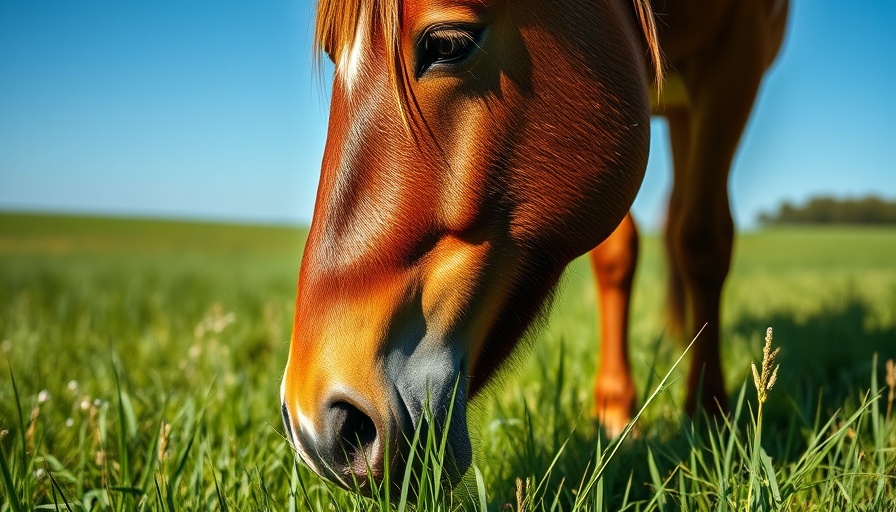
The Significance of Grazing Muzzles: More Than Just an Oddity
Many horse owners and passersby have likely wondered about the peculiar sight of a horse wearing a muzzle while grazing. For those unfamiliar with equine care, this may appear simply futile or even amusing, but the truth is that grazing muzzles carry substantial health benefits for horses facing various dietary challenges.
What Exactly is a Horse Grazing Muzzle?
A horse grazing muzzle is a safety device made from durable fabric or plastic that fits comfortably over the horse's mouth, secured with straps around the ears. This clever invention allows horse owners to monitor and control the quantity of grass their horses consume, which can be especially important in lush pastures, where overindulgence is common.
Grazing muzzles feature varying hole sizes, allowing horses to consume specific amounts of forage. This setup not only helps to regulate their diet but also ensures that they can drink water freely, making these muzzles ideal for pasture use. However, it's essential to note that they are less effective for hay, a situation where hay nets would serve better if intake restriction is necessary.
The Need for Grazing Muzzles: Unpacking the Benefits
Why might a horse necessitate wearing a grazing muzzle? There are several compelling reasons:
- Obesity: Horses that strive to maintain a **healthy weight** can significantly benefit from grazing muzzles. Excess grass intake can lead to obesity, with a body condition score (BCS) of 7 or above indicating obesity.
- Laminitis Prevention: This painful condition, resulting from inflammation of the laminae in a horse's hoof, can be prompted by excessive sugar intake from lush grass. A grazing muzzle can assist in managing their diet and preventing this debilitating ailment.
- Pasture Management: For horse owners lacking the ability to rotate pastures, grazing muzzles can help prevent overgrazing, allowing grass time to recuperate and grow, thus promoting sustainable pasture health.
- Managing Metabolic Conditions: Horses with specific metabolic issues, such as Equine Metabolic Syndrome (EMS), benefit from grazing muzzles by limiting their access to grass and controlling their overall carbohydrate intake.
Understanding How to Use Grazing Muzzles
When integrating grazing muzzles into their horses' routines, owners should adhere to best practices for usage. Typically, grazing muzzles should not be worn for more than 10 to 12 hours a day to ensure the horses remain comfortable and do not suffer from distress due to prolonged confinement.
Many owners prefer using grazing muzzles during pasture turnout times while ensuring that a suitable amount of hay is provided, especially if the muzzle limits pasture consumption. It's crucial to monitor horses closely while they're wearing muzzles to ensure their comfort and safety.
The Emotional Connection: Horses and Their Comfort
For many, horses are more than just companion animals; they are part of the family. The emotional bond between horse owners and their animals can run deep, filled with shared experiences and companionship. By properly managing their diets and health through the use of grazing muzzles, owners can foster a sense of well-being and security for their equine friends.
It’s essential for horse owners to recognize that a grazing muzzle, while appearing odd, is truly a **tool of compassion**. By ensuring that a horse stays healthy and maintains a comfortable lifestyle, a muzzle can help a horse live a longer and happier life.
In Conclusion: The Remarkable Benefits of Grazing Muzzles
In the equine world, tools like grazing muzzles symbolize the commitment owners have to their horses' health. While the sight of a horse wearing a muzzle may initially seem unusual, this equipment serves a significant purpose in preventing obesity, managing metabolic conditions, and fostering effective pasture management.
For enthusiastic horse owners, understanding the role of grazing muzzles not only equips them with knowledge but also emphasizes their dedication to the well-being of these majestic animals. By contributing to horses' health and longevity through proper use of muzzles, owners create a harmonious balance between safeguarding their horse's diet and ensuring their happiness.
Whether you are a long-time horse owner or a newcomer to the equestrian community, consider exploring the world of grazing muzzles as an invaluable addition to your horse care toolkit.
 Add Row
Add Row  Add
Add 


Write A Comment